While a select few are honored by a window on Main Street, U.S.A. at Disneyland Park in California or Magic Kingdom Park in Florida, even fewer can claim direct connections to shops on the same street.

Robert Sherman, Jimmy Johnson, Tutti Camarata and Richard Sherman
James A. “Jimmy” Johnson, born August 8, 1917, opened one of the shops himself, under the direction of Walt Disney in 1955. The Wonderland Music Store sat on the corner of Main Street and Town Square, boasting a player piano and a selection of rolls, in addition to the latest in popular records and Disney-related titles. (There were no Disneyland Records in stock yet as the company did not have its own record company. That would happen the following Spring.)
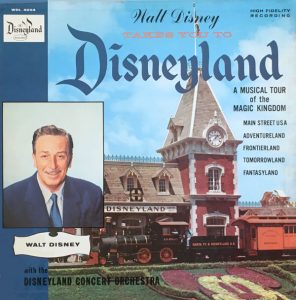 It was Johnson who convinced Roy, for whom he worked as part of Merchandise and Publishing, that the studio would do well by bringing in the production, manufacturing, and marketing of their own records instead of letting other companies share the profits. Walt and Roy were reluctant for thirty-three years. It took the enormous success of “The Ballad of Davy Crockett” (on another label) and the Mickey Mouse Club records (on another label as well) to finally convince them. Walt himself recorded the first album they produced in-house, manufactured, and marketed, and we talked about it in this Animation Spin.
It was Johnson who convinced Roy, for whom he worked as part of Merchandise and Publishing, that the studio would do well by bringing in the production, manufacturing, and marketing of their own records instead of letting other companies share the profits. Walt and Roy were reluctant for thirty-three years. It took the enormous success of “The Ballad of Davy Crockett” (on another label) and the Mickey Mouse Club records (on another label as well) to finally convince them. Walt himself recorded the first album they produced in-house, manufactured, and marketed, and we talked about it in this Animation Spin.
If you have read other Animation Spins, you may already know how Johnson’s astute hiring of Tutti Camarata created a perfect balance of creative and business savvy. When Annette and the Sherman brothers started hitting the top ten, that led to Walt adding the brothers to the staff, which led to the game-changing Mary Poppins, which provided financing for the land purchase and construction of the Walt Disney World Resort, which is still one of the strongest assets of The Walt Disney Company. Johnson’s Disneyland/Buena Vista Records and Walt Disney Music Company have grown to multiple labels, products, and enterprises.
Jimmy Johnson is rarely recognized for several other key contributions, particularly one that has inspired countless animation professionals, historians, and enthusiasts. Walt assigned him to coordinate the publication of the fabled book, The Art of Animation. According to Johnson’s 1975 autobiography, Inside the Whimsy-Works: My Life with Walt Disney Productions (published posthumously by University Press of Mississippi), the original author of The Art of Animation was supposed to be Don Graham.
Graham was hired to teach the Disney animators at a nearby studio annex after he had sent his artists to Chouinard Institute to sharpen their art skills (you can see him in the art class scene in 1941’s The Reluctant Dragon).
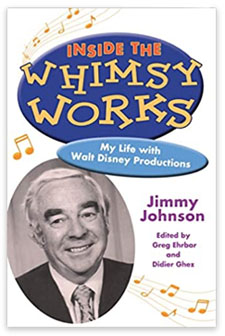 Johnson continued in his memoir:
Johnson continued in his memoir:
“Don worked for several years on the project, compiling some very valuable research material. Walt found his writing too “scholastic.” He wanted the book to be one of general interest, not just a textbook for artists. So Walt asked me, as head of Disney publications, to find a writer for the book.
“On a New York trip, I met Howard Barnes, former drama and movie critic for The New York Herald Tribune. Howard’s reviews of Disney films for the Tribune had not been puffs but were eminently fair and very respectful of animation as an art. Howard was “at liberty” and interested in doing the project, so I recommended him to Walt.
“Howard came to the studio and began work on the book, using Don Graham’s research as a basis. He completed about seven chapters, but Walt found his writing too breezy. He felt that Howard was not making sufficient use of Don Graham’s research. Howard was dismissed from the job and my search began anew.
“This time I came up with Bob Thomas, who had been the Associated Press man on the Hollywood scene since 1944. I worked very closely with Bob on the book as did many others at the studio.
“The Art of Animation was finally published in 1958 by Simon and Schuster. The credits read: “Designed by the Walt Disney Studio. Produced by the Sandpiper Press and Artist’s and Writer’s Press, Inc. Printed in the U.S.A. by Western Printing and Lithographing Co.” The writing credits read: “Walt Disney, The Art of Animation, the story of the Disney studios contribution to a new art. By Bob Thomas with the Walt Disney staff with research by Don Graham.” I didn’t have any official title in connection with The Art of Animation but I did coordinate the entire project. One of my contributions was the compilation of the animation credits found in the appendix of the book.
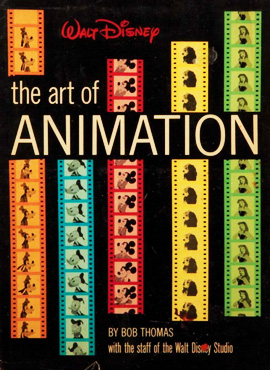 “In the last year of his life, Walt was asked what he considered his greatest accomplishment. He said immediately, “The creation of my organization.” The compilation of animation credits in The Art of Animation was the first such listing of the creative contribution of Walt Disney’s organization … the book The Art of Animation, which enjoyed a limited success in its first release, has become one of the pillars of the Disney bibliography. Bob Thomas has gone on to become one of the principal chroniclers of Hollywood greats, having done biographies of Cohn, Thalberg, and Selznick. He is the author of a children’s biography of Walt Disney and is presently engaged in writing the official, studio, and family-authorized biography of Walt.”
“In the last year of his life, Walt was asked what he considered his greatest accomplishment. He said immediately, “The creation of my organization.” The compilation of animation credits in The Art of Animation was the first such listing of the creative contribution of Walt Disney’s organization … the book The Art of Animation, which enjoyed a limited success in its first release, has become one of the pillars of the Disney bibliography. Bob Thomas has gone on to become one of the principal chroniclers of Hollywood greats, having done biographies of Cohn, Thalberg, and Selznick. He is the author of a children’s biography of Walt Disney and is presently engaged in writing the official, studio, and family-authorized biography of Walt.”
Johnson later put together a record album with producer Tutti Camarata that was, in effect, the musical version of The Art of Animation. It was called Walt Disney’s Music Cavalcade, a two-disc documentary with text, graphics, and illustrations direct from the book. We did an Animation Spin about this unique album here.
During his years at Publishing, Johnson also revived Disney’s magazine trade. Which had been dormant in the U.S. for fifteen years. From his book:
“The first Walt Disney magazines produced in the United States were “general”-type periodicals containing articles, stories, puzzles, and games. The first one was produced by Kay Kamen in January 1933, and it continued until September of that year. The second Disney magazine began in November 1933 and was edited by Hal Horne. This magazine lasted until October 1935. The third was the brainchild of Hal Horne and it was licensed by Kay Kamen as a regular periodical to be sold in newsstands, not as a promotional vehicle as the first two magazines had been.
 “While the third magazine was an excellent book, Hal Horne lost money in the venture and it was taken over by Kay Kamen in 1936. Kay continued the magazine until September 1940, when it disappeared from the scene. Its place was taken by the first Disney comic magazine.
“While the third magazine was an excellent book, Hal Horne lost money in the venture and it was taken over by Kay Kamen in 1936. Kay continued the magazine until September 1940, when it disappeared from the scene. Its place was taken by the first Disney comic magazine.
“While Disney general-type magazines continue to be very successful in other countries of the world, there was no such Disney magazine in the United States from 1940 until 1956. At that time a new Disney magazine was launched in connection with the very successful Mickey Mouse Club television show.
The Disneys’ ability to use one facet of their business to sell another was revealed again in the new Mickey Mouse Club Magazine, which was sold entirely by commercials on the Mickey Mouse Club TV show. At first, the magazine was a quarterly and it cost one dollar a year to subscribe. Later it was issued every other month. I was selected as the Managing Editor of the new publication with a big assist from Johnny Jackson as Editor. The first masthead read: ‘Walt Disney, editor-in-chief; Mickey and Minnie Mouse, honorary editors; Hal Adelquist, Bob Callender, Johnny Jackson, Jimmy Johnson, Card Walker, Bill Walsh, editorial board; Jimmy Johnson, managing editor; Johnny Jackson, editor.’
 “Walt Disney’s Magazine was aimed at a much higher age level than the audience the Mickey Mouse Club television show was reaching. Thus the circulation began dwindling and the magazine was discontinued after Volume Four, Number Five.
“Walt Disney’s Magazine was aimed at a much higher age level than the audience the Mickey Mouse Club television show was reaching. Thus the circulation began dwindling and the magazine was discontinued after Volume Four, Number Five.
“I am very proud of the fact that this high-quality material, created for Walt Disney’s Magazine in the period 1956-1958, has been used and reused in new Disney magazines in the United States, such as the Gulf Wonderful World of Disney premium magazine of the late 1960s. The Walt Disney’s Magazine material has also been used in Disney publications around the globe.”
Gulf was one of the sponsors of The Wonderful World of Disney on NBC Sunday nights in the late sixties. Some expense went into creating humorous commercials to make readers eager to pick up the newest editions of what began as the Mickey Mouse Club and Walt Disney’s magazines. It was a New York casting, as the characters are voiced by Allen Swift (Mad Monster Party, Underdog), and the announcer is Roger Davis (Dark Shadows, Alias Smith and Jones). This is one of the national commercials:
The material in these magazines continued to be reused in various magazines, including Comet cleanser’s Disney Magazine in the late seventies, and reprint book compilations. Among the reprint books that used some of the magazine material, like the “Junior Woodchuck Guides” were slip-cased Golden book sets, each containing four thick hardcover volumes, sold only by direct mail. One was called The Wonderful Worlds of Walt Disney and the other was Walt Disney Parade.
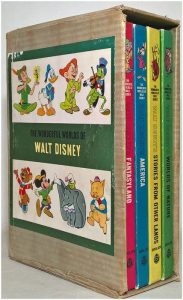 These came about after Jimmy Johnson started direct marketing at Disneyland Records (the first direct marketing of any kind at Disney). This occurred after he started the recording division. Instead of a record club, the mail offers presented either a selection of single albums or Storytellers for “one low price.” It was so successful that Western Publishing, makers of Golden Books, an initial investor in Disneyland and one of Disney’s most important publishing partners, asked Johnson about direct mail books. What happened says something about Roy Disney’s character:
These came about after Jimmy Johnson started direct marketing at Disneyland Records (the first direct marketing of any kind at Disney). This occurred after he started the recording division. Instead of a record club, the mail offers presented either a selection of single albums or Storytellers for “one low price.” It was so successful that Western Publishing, makers of Golden Books, an initial investor in Disneyland and one of Disney’s most important publishing partners, asked Johnson about direct mail books. What happened says something about Roy Disney’s character:
“About a year and a half after we first started direct mail offers for records, there came a proposition from our publishing licensee, Western Printing, that we get into the direct mail business on Disney books. A four-book set was put together using old material from Disney books and magazines.
“I was all for our buying the printing from Western, owning the inventory ourselves, and proceeding as we had with records. But for one of the few times in his life, Roy Disney decided against “doing it ourselves” and instead licensed Western to do the four-book set.
The Wonderful Worlds of Walt Disney became a true phenomenon in the direct mail business. It was probably one of the most successful direct mail offers ever made, selling literally millions of sets in the U.S. and abroad. It is true that the Disney organization collected many thousands of dollars in royalties and had no inventory risk, but if we had gone it alone and just bought the book printing from Western, it would have been a total bonanza.
 “Roy’s policy of ‘let’s do it ourselves,’ in which Walt fully concurred, had resulted in our being in the music publishing business ourselves, the phonograph record business ourselves, the film distribution business ourselves (through the formation of Buena Vista Film Distribution in 1953), the television syndication business ourselves and in the educational materials business ourselves.
“Roy’s policy of ‘let’s do it ourselves,’ in which Walt fully concurred, had resulted in our being in the music publishing business ourselves, the phonograph record business ourselves, the film distribution business ourselves (through the formation of Buena Vista Film Distribution in 1953), the television syndication business ourselves and in the educational materials business ourselves.
“I never knew why we didn’t do direct mail ourselves on books. But I sometimes suspect Roy felt a bit guilty over the paltry return Western Printing got on its initial Disneyland investment, especially compared to the big profits ABC reaped. Giving the book direct mail rights to Western on a license may have been his way of thanking [Western executive] Ed Wadewitz (then gone) and Western for their help.”
Walt asked Johnson to run the Wonderland Music store on Main Street in addition to running the music and record companies. He moved his whole family near the Disneyland site in Anaheim temporarily as the park and the shop took shape, commuting to the Burbank studio on alternate days. He recalled:
“Disneyland Park had to open on July 17, 1955; the national television show had been scheduled for broadcast from the Park and it had been widely ballyhooed. It was created to help sell the park, so it would never do to show a half-finished place. A week before the l7th, I didn’t think we’d ever make it even though activity day and night was frenetic.
 “Saturday night before the big day, the job still was not finished. Bright floodlights were everywhere and hundreds of workmen were scurrying around.
“Saturday night before the big day, the job still was not finished. Bright floodlights were everywhere and hundreds of workmen were scurrying around.
“My music store wasn’t finished either. That Saturday night found my people and me papering the walls with old sheet music covers. We slapped on the last old cover at about three in the morning.
“The Wonderland Music Store had a very advantageous spot on the right-hand side of Main Street, U.S.A. When you entered the park proper, after Town Square, first came the Wurlitzer Organ display and then the music store.
“The flow of people entering the park was always to the right-hand side of Main Street, U.S.A. When the gates were opened in the mornings, and for several hours thereafter, the people would swarm in, walking four and five abreast.”
Johnson also consulted on the attractions Country Bear Jamboree and America Sings. He wrote:
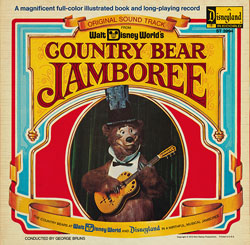 “Marc Davis was the principal architect on each and I happened to be lucky enough to be in at the inception of both attractions … In the creation of a musical Audio-Animatronics show, the character sketches come first. Then comes the selection of the music for them to play and sing.
“Marc Davis was the principal architect on each and I happened to be lucky enough to be in at the inception of both attractions … In the creation of a musical Audio-Animatronics show, the character sketches come first. Then comes the selection of the music for them to play and sing.
“This is no easy task. The song must fit the character; it has to be the kind of music which can lead to sight gags, because the show is visual first and musical second, and the songs selected must lend themselves to a well-paced show. My assistant, Rose Mussi, and I flooded Marc Davis and Al Bertino with literally hundreds of country records to help them make the final selection.
“Marc needed a bigger and broader cast of characters and he got his chance with the idea for America Sings. This would be a cavalcade of American music, from “Yankee Doodle” to “Shake, Rattle and Roll.” The songs would be played and sung by a large cast of birds and animals, everything from a jackass to an eagle.
“The problem of music selection for America Sings was enormous. In addition to all the limiting factors described in creating the bear show, WED had the problem of the very long period of musical history which would be covered. There wasn’t time to play any song in its entirety and yet enough had to be played for the tune to be recognized.
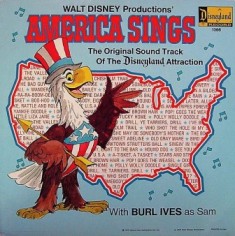 “Rose and I again scoured the rare record shops, as well as the regular shops, and furnished Marc and Al with a ton of records. They put together the first three acts of the show but asked us to help in the selection of the tunes for the last act, modern times. Using some of our Disneyland Records, as well as records from other labels, we put together a little rough soundtrack. We both got a great kick out of the fact that many of our suggestions wound up in the final show, from Ja Da to Hound Dog.”
“Rose and I again scoured the rare record shops, as well as the regular shops, and furnished Marc and Al with a ton of records. They put together the first three acts of the show but asked us to help in the selection of the tunes for the last act, modern times. Using some of our Disneyland Records, as well as records from other labels, we put together a little rough soundtrack. We both got a great kick out of the fact that many of our suggestions wound up in the final show, from Ja Da to Hound Dog.”
Years after the Wonderland Music Store closed, Disney Music Group producer/historian randy Thornton brought it back in a different way, in both Florida and California, after the turn of this century. Direct-to-disc kiosks bearing the Wonderland Music Store name were installed at Disneyland and Walt Disney World locations, offering a wide variety of recent and classic Disney and Buena Vista records.
The Wonderland Music Store is currently honored in the logo design of a current online retail outlet called the Disney Music Emporium. And the currently-existing 20th Century Music Company stands on Main Street, U.S.A. in Disneyland as a tribute to Jimmy Johnson’s original shop. For many years the shop sold vinyl and compact discs, giving way to other gifts and memorabilia now that music selections can be streamed or downloaded from practically anywhere (but not piano rolls). Spotify is a particularly good place to find official Disney playlists, including the only “Best Of” playlist (to date) devoted to a single recording artist … Annette.
For more fascinating insider Disney stories– from daily commutes to work with Jimmy’s pal Steven Bosustow to luncheons with “salty-tongued” Suzanne Pleshette, just download, listen to or get a copy of Jimmy Johnson’s Inside the Whimsy Works.
“Blackbeard’s Ghost” Storyteller Narration
Jimmy Johnson’s dream was to be a Disney story artist (he describes the application process in his book). In a way, his dream came true, because he wrote almost every Disneyland Storyteller album in the sixties and early seventies, including the iconic Haunted Mansion LP. One of the best compliments he ever received came from actor/writer/director Peter Ustinov. In addition to writing narration around the soundtrack dialogue excerpts for the 1968 Blackbeard’s Ghost album, Johnson wrote a witty ten-minute Blackbeard monologue especially for the Oscar-winner, who expressed delight with the results.
(Special thanks to the University Press of Mississippi, who were kind enough to allow us to reprint all the excerpts above.)


 GREG EHRBAR is a freelance writer/producer for television, advertising, books, theme parks and stage. Greg has worked on content for such studios as Disney, Warner and Universal, with some of Hollywood’s biggest stars. His numerous books include Mouse Tracks: The Story of Walt Disney Records (with Tim Hollis). Visit
GREG EHRBAR is a freelance writer/producer for television, advertising, books, theme parks and stage. Greg has worked on content for such studios as Disney, Warner and Universal, with some of Hollywood’s biggest stars. His numerous books include Mouse Tracks: The Story of Walt Disney Records (with Tim Hollis). Visit 





















































Strange to see Iron Eyes Cody grinning broadly in a TV commercial, instead of shedding a tear….
If I saw a magazine masthead listing the two top editors as Jimmy Johnson and Johnny Jackson, I would assume that every single name on it was a pseudonym.
Peter Ustinov really must have been delighted with Johnson’s monologue. If he hadn’t been, he wouldn’t have hesitated to change it. But I had to laugh out loud when Dean Jones mentioned the “poor unfortunate souls” — now that’s a Disney song cue if ever I heard one!
“Poor unfortunate souls, grubbing and digging in the dirt?”
“I’m not good for nothing, I’m not!”
“Oh, don’t start crying again!”
What a great script. It was like Disney meets Neil Simon, seriously, and the pairing of Jones and Ustinov was like Randall and Klugman.
This is a fascinating inside look at the synergy of the many Disney products that were coordinated during that highly creative period of the mid-50’s into the early 70’s. It’s interesting how Jimmy Johnson was involved in so much more than music.
I remember that box set of “The Wonderful Worlds of Walt Disney”. It seemed nearly every one of my friends owned it. My parents were concerned that it would lead to a major financial obligation, so they did not order the box set, although I know they were aware of it. I didn’t get a copy myself until my teens when I found a set of the books (without the slip cover) at a school rummage sale. (Fantasyland was, and still is, missing the title page.)
As for the “Wonderful World of Disney” magazine, that was a rare and wonderful treat. I do not recall those TV commercials, but the little factoids mentioned were indeed referenced in some of the issues. The little boy in the ad looks like Barry Livingston from “My Three Sons,” although not enough of him is shown to be sure. Possibly it was another young actor who was supposed to look like him. I myself was almost exactly that age at the time (and about as nerdy-looking!).
One correction. You wrote “When Annette and the Sherman brothers started hitting the top ten, that led to Walt putting them on staff…” At the time, Annette was already under contract to Disney. I think you mean the Sherman Brothers were put on staff.
Thanks for another excellent post! I look forward to hearing about your forthcoming book. Consider at least one copy as sold already!
Thanks, Frederick, we made the correction. As for the Wonderful World of Disney books, I used to repeatedly check them out of the library, along with The Art of Animation and Robert Osborne’s Academy Awards book. I had no idea the Wonderful World and Parade books could be ordered as sets until years later when they were reissued, and there was much rejoicing.
What a fantastic job of research and smooth writing! This was a blast to read!
Your words are very deeply appreciated, David. This was an especially important post to me and to the Johnson family, who were thrilled when Jimmy received his legend award and when “Whimsy Works” was finally published after so many years of wishing, dreaming and wondering if it would ever happen. I never say never.
A swell post. That TV spot is an hilarious blast from the past.
If you enjoyed this look at Disney history, I thoroughly recommend Jimmy Johnson’s excellent “Inside the Whimsy-Works: My Life with Walt Disney Productions.”
Thank you! I remember the commercial in which they show a misty bridge and the announcer talks about a strange creature who lurks underneath, stating, “Want to know who it is? The answer is on page 23.” I had the magazine on the school bus and the kids were asking me to find the page — such was the impact of the ads. It was a full spread about “The creature of the month,” a troll.
Anything that could make the kids on the school bus treat you with respect was like solid gold.
“When Annette and the Sherman brothers started hitting the top ten….” While they had several records that charted, I think they only broke the Top Ten once, with “Tall Paul” in 1959. I love that song, of course, but I’m glad it had mostly been forgotten when I was growing up, or I’d have never heard the end of it!
Annette had TWO top ten singles and a top 20 single, three top 40 albums, and a total of ten top 100 hits.
From Billboard (which mispelled her name but that’s okay because they’re Billboard):
“Funnicello {SP] charted 10 hits on the Billboard Hot 100 chart between 1959 and 1961 (under the name “Annette”). Of those, two went top 10: “Tall Paul” (No. 7 in 1959) and “O Dio Mio” (No. 10, 1960). She was so popular in 1959 and 1960 on the chart, she had the second-most Hot 100 hits among female acts in that span of time. She charted nine entries — second only to Connie Francis, who notched 16 in those two years. On the Billboard 200, she charted three top 40 albums in 1960-1963 with “Annette Sings Anka” (No. 21), “Hawaiiannette” (No. 38) and “Annette’s Beach Party” (No. 39).”
I was able to purchase “The Wonderful Worlds of Walt Disney” with slipcase several years ago at a used book store in Fort Wayne, IN. Score! And I have very fond memories of the Gulf Disney magazines from when I was a child in the late ’60s. I especially remember devouring the one with “The Jungle Book” on the cover during a trip to Chicago. I had just seen “The Jungle Book” a few months earlier (the first film I ever saw in a theater). Many decades later, I was able to buy all of the Gulf magazines on eBay.
Amazing job Greg! Thank you for this. My sisters and I completely agree–the research, the connecting the dots to my Dad’s book–all of it so well-done that i learned (or remembered) a few things I didn’t know before myself. Your dedication to “Whimsyworks” was total and your intelligence and dedication to continuing the tribute through posts like this are so welcome. Your work fills a needed place by filling in the important, often unsung, history of the Disney organization as it became the juggernaut we know today.
Grey Johnson, Jimmy’s son, also deserves credit and our thanks for getting his father’s book into print and providing a superbly written introduction.
What a great look at the career of Jimmy Johnson! He was really at the heart of informing my childhood. The Wonderful Worlds of Disney were a huge hit at my house growing up; so much so that when I inherited the books they were very tattered. A couple of years ago I stumbled across a nearly new set at a thrift store, and of course I brought them home! My granddaughter and I are now reading them together. Jimmy’s legacy continues!